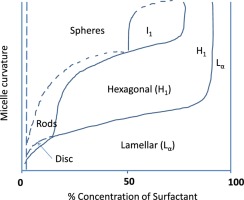Journal of the Taiwan Institute of Chemical Engineers ( IF 5.5 ) Pub Date : 2018-02-27 , DOI: 10.1016/j.jtice.2018.02.011 Gordon J.T. Tiddy

|
Water is the most common component in almost all surfactant and colloid products, being present in the manufacture processes and/or the final product. Concentrated surfactants form liquid crystals with various structures (lamellar, hexagonal, cubic, etc.) and a wide range of properties. The link between surfactant structure and liquid crystal architecture (“nanostructure”) has been established. In dilute solutions the hydrophobic effect (an entropic mechanism) underpins the formation of micelles, the building blocks of liquid crystals. Water next to hydrocarbon chains is at lower entropy due to sampling a reduced number of configurations compared to bulk water. In the past, explanations of this entropy decrease have invoked layers of “structured water” which are not supported by experiment. Liquid crystals have long-range ordered structures as with conventional crystals (solids). The nuclear magnetic resonance (NMR) spectra of non-cubic liquid crystals exhibit multiple transitions (quadrupole splittings) which reflect the mobility and degree of ordering of water and ions. Measurements on both ionic and non-ionic surfactants show three different states of water: free, bound and “disrupted”. A simple model predicts that the amount of bound water passes through a maximum with increasing surfactant concentration. Counter intuitively, at very high surfactant concentrations there is an increase in free water levels.
中文翻译:

浓缩表面活性剂和胶体体系中水的性质
水是几乎所有表面活性剂和胶体产品中最常见的成分,存在于制造过程和/或最终产品中。浓缩的表面活性剂形成具有各种结构(层状,六边形,立方等)的液晶。)和广泛的属性。表面活性剂结构和液晶结构(“纳米结构”)之间的联系已经建立。在稀溶液中,疏水作用(一种熵机制)巩固了胶束的形成,胶束是液晶的组成部分。碳氢化合物链旁的水具有较低的熵,这是因为与大量水相比,采样的配置数量减少了。过去,对这种熵降低的解释是调用了“结构化水”层,而这些层并没有得到实验的支持。液晶具有与常规晶体(固体)一样的长程有序结构。非立方液晶的核磁共振(NMR)光谱显示出多个跃迁(四极分裂),反映了水和离子的迁移率和有序度。离子表面活性剂和非离子表面活性剂的测量结果都显示出三种不同的水状态:游离,结合和“破坏”。一个简单的模型可以预测,随着表面活性剂浓度的增加,结合水的量将通过最大值。直觉上相反,在非常高的表面活性剂浓度下,自由水含量会增加。











































 京公网安备 11010802027423号
京公网安备 11010802027423号